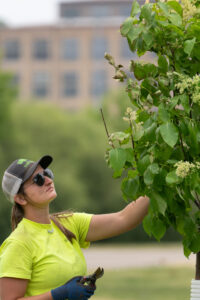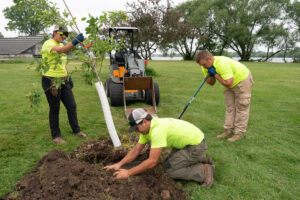What is Legacy-Trees?
Legacy-Trees is a system of producing trees that works in concert with the tree’s root system to mimic how tree roots grow in the forest. Our system encourages this natural root development and delivers a balanced root system that is ready to immediately colonize your property. We combine this system of production and transplanting to bring you a superior tree that will be there for generations. Click here to learn more.
Do you offer a warranty?
 Our system is backed with a five-year warranty on the tree when you enroll in our Stewardship Program.
Our system is backed with a five-year warranty on the tree when you enroll in our Stewardship Program.
What is the "Tree Stewardship Program"?
Legacy-Trees and network companies give the option for customers to purchase the 5-Year Warranty upon installation of the Legacy-Tree. All trees come with an automatic 1-Year warranty. When purchasing the warranty, the company will come back and prune this tree 3-5 times in 3-5 years.
The are three levels of the Legacy-Tree Stewardship Program: juvenile pruning, soil resource management, and plant health care. Customers can opt for whatever level of aftercare they would like. At a minimum, to receive the 5-Year Warranty, customers must opt into level one which is juvenile pruning in the first 5 years.
In the first phase of a tree’s life known as the “juvenile growth phase” the tree is trying to outcompete competitors from the forest ecosystem it evolved in. In a customer’s yard, this leads to quick growth and improper branch angles that will eventually split out in a storm later in the tree’s life if we don’t prune them when the tree is young.
In the forest, these juvenile branches received too much shade as the forest grew taller and would be self-pruned at a small size. On a customer’s property, this self-pruning does not occur and therefore storm damage occurs as the tree becomes mature.
Stewardship Level 1: To create a healthy mature tree, Legacy-Trees network companies prune the first 1/3 of the tree of all branches, on larger shade trees this can be the first 20 feet of the trunk over the span of 5 years.
Stewardship Level ll: This involves managing the soil resources of sites that lack all the adequate resources for tree growth. Legacy-Trees provides a fertility strategy to ensure that your new tree can grow in all directions.
Stewardship Level lll: The final phase of stewardship is plant health care. This is managing all aspects of tree health. Certain species can be more susceptible to pests or disease at certain stages of life. To promote diversity on your site, our network partners need to be able to help trees along at critical stages in their life when they may need it to avoid pests or disease damage.
The overall goal of stewardship is to establish each tree from day one as an investment that will grow to outlive everyone there to plant it. By becoming stewards of your Legacy-Trees aggressively in the first 5 years these trees will become magnificent specimens and examples of the best of their species.
Why do I want Diversity?
Chestnut Blight, Dutch Elm Disease, and Emerald Ash Borer are classic examples of what can happen when disease or insects invade our communities and take away large numbers of trees. Customers can rest assured knowing that choosing a Legacy-Trees affiliated company means there will be someone advocating for diversity in our urban forests. Choosing a Legacy-Trees network company means that customers will be educated on all the areas of the property they can plant trees and all the variety that Legacy carries to reach diversity goals. Click HERE to learn more about our diversity champions program.
How much experience is there behind Legacy-Trees?
A collateral benefit of this network is the investment that is made in training the employees from each member company. Every employee whether they are field staff, management, or office staff will receive training to support their knowledge of how trees grow and why this system is so important for long-term tree success. This combined with educating the existing customer base creates an opportunity to separate each company from competitors in their respective markets. Learn More about the President of Legacy-Trees, Ron Zillmer.
When should I plant my trees?
 Not all at once, that’s for sure! Throughout the year, the trees can be planted from April through freeze up in the fall. We do not encourage planting all of the trees on your plan in one season. This is an investment type strategy that encourages property owners to add trees over a series of years to allow the plan to evolve over time as the trees in your landscape age.
Not all at once, that’s for sure! Throughout the year, the trees can be planted from April through freeze up in the fall. We do not encourage planting all of the trees on your plan in one season. This is an investment type strategy that encourages property owners to add trees over a series of years to allow the plan to evolve over time as the trees in your landscape age.
What trees do you offer?
The Legacy-Trees menu that we provide each year will vary as we cannot provide every type of tree on a cost-effective basis each year. Legacy will make every effort to support diversity plans for customer’s properties and will have trees available on a three-to-five-year rotational cycle. If there is a type of tree a customer must have, let us know and we will make every effort to grow one for you! See our list of trees here.
How big are the trees?
All of our trees are the same age and based on species growth differences – they do vary in size at planting time. Our goal is that all trees are 2″ in diameter measured 6″ off the ground. Shade trees should be 12 to 15 feet in height, and ornamentals should be 8 to 12 feet in height.
Call us for more specifics!
What is Legacy-Tree’s Parade of Color™?
Legacy-Tree’s Parade of Color™ symbolizes the sequence of flowering our ornamental trees can provide in the spring each year. Here is an example of our Parade of Color™ that our ornamental trees created for the La Crosse, WI region over the past few years. The flowering season kicks off with a Autumn Brilliance Serviceberry in late April producing remarkable white flowers before the forest has fully awoken. An interesting fact about this tree is that it will produce a full flower set in full shade which is unusual for our flowering ornamental trees. The berries provide great bird watching action and the name is derived from the brilliant fall color! Following the departure of the serviceberry flowers the next trees in line are the flowering pears, hawthorns, and crabapples. The pears and hawthorns typically have white flowers whereas the flowering crabapples range from white to red to pink/purple. Combinations of these three varieties of trees can create a spectacular contrast during the middle of the season. Flowering crabapples have come a long way with modern breeding techniques. Today’s crabapples are highly disease resistant, and many have persistent fruit. So, the crabapples you may remember from years gone by that dropped their leaves during the summer and then dumped loads of mushy crabapples on the ground are not what we are bringing to you today. The leaves dropped from a disease called Apple Scab which is a fungus and the fruit dropped at maturity just like the regular apple trees are programmed to do. Modern crabapples are bred to be highly disease resistant, and the fruit is held on the tree for most of the winter into spring. That allows wildlife to take advantage of this food source all winter and keeps the area under your crabapple trees free of the mess! My favorite sight in the spring is seeing Robins eating the crabapples after a late snow fall. The final act of Legacy-Tree’s Parade of Color™ ornamental trees is the Japanese Tree Lilacs exploding with blossoms in early June! This is truly one of my favorite trees as it flowers after the other trees have moved on and it concludes the six-week flowering season created by our Parade of Color™ trees! This tree also features a shiny bark and pronounced lenticels to create a striking appearance all year.
Why Legacy Trees?
Warranty
The Legacy-Trees system is backed with a 5-year warranty on the tree. Upon enrollment in the Stewardship Program: Level l, Legacy-Trees network partner will make a minimum of three site visits with a trained professional on staff within the first five years.
Investing in a Legacy Tree is a long-term commitment, and our warranty underscores our confidence in the quality of our trees and the effectiveness of our initial care. This guarantee helps homeowners and property managers ensure their landscape investment thrives, offering lasting beauty and environmental benefits.


Legacy-Trees Experts
To further ensure the long-term survival of each tree and all of the trees you are adding to your property, we invest in extensive training of our people to facilitate the proper planning, planting, and stewardship of your urban forest!
Our dedicated team of Legacy-Trees experts brings specialized knowledge in arboriculture and sustainable landscaping practices. This expertise is crucial for selecting the right tree species and implementing planting techniques that promote healthy growth and resilience in the local climate and soil conditions.
Site Assessments
Each property, regardless of size, has varying conditions that are similar to various ecosystems where trees come from. Assessing the site conditions helps us to match the trees that are native to those conditions which truly holds the key to long term survival.
Understanding the nuances of your property, from soil composition and drainage to sunlight exposure and surrounding vegetation, is fundamental to the success of your Legacy Tree. Our comprehensive site assessments ensure optimal tree selection and placement, maximizing their adaptation and contribution to the local ecosystem.

Legacy-Tree Lessons
-

How The Legacy Began
-

Planting Pitfalls: The Long-Term Consequences of Planting Trees Too Deep
-

30 Seconds in the Life or Death of a Tree
-

Fall's Beauty Unleashed: The Autumn Blaze Maple
-

Autumn Brilliance Service Berry: A Closer Look
-

Growth Comparison: Fall Fiesta Sugar Maple vs One-Year Older Tree
-

Role of Stewardship in Shaping Urban Forests: A Legacy-Trees Narrative
-

Fall Fiesta Sugar Maple: A Closer Look
-

Importance of Branch Clearance: Self Pruning Trees
-

Timeless Tales from An Old Elm: On Location in Milladore, WI
-

Flare Fundamentals: Comparing Traditional Root Flares in Forests and Urban Settings
-

Guardians of the Ground: Mulches and Rock Beds for Protecting Tree Roots
-

Living Lessons from the Red Pine: Understanding Self-Pruning in the Wild
-

Root Exposure | How It Works
-

Below the Surface: Understanding the Root Zone within the Soil Profile
-

The Siouxland Poplar: Discovering the Tree of Versatility
-

Revolutionizing Tree Care: A Synopsis of Ron Zillmer's "20 Minutes in the Life or Death of a Tree"
